Paul Carey-Kent Surveys A CHOICE FROM WINNIPEG
I’ve just had the chance to visit Winnipeg (population 700,000, Canada’s 8th largest), which is an unusual city: set in the middle of the prairies it’s the world’s coldest and also one of the most isolated – 500 miles from the nearest city, Minneapolis. Those factors, together with an eccentric history and an atypically large proportion of aboriginals (10% against an all-Canada average of 4%), make it a distinctive place to make art. Cheap rents,and good support from the Federal Government, the state of Manitoba and the city itself help ensure that there are plenty of artists. I visited at a good time, catching surveys of current trends at the main public institutions (‘My Winnipeg’ at the Plug In Institute of Contemporary Art and ‘Winnipeg Now’ at the Winnipeg Art Gallery, guest curated by Plug In’s Meeka Walsh and Robert Enright) and an all night opening of galleries for the ‘Nuit Blanche’ of 29 September. What’s more, the artists all know each other, so it’s not hard to make your way round between people and studios. The following sets out what the three arguably most famous Winnipeg artists were showing, and provides fuller profiles of some whom I found particularly interesting.
Marcel Dzama, the best-known of the former members of Royal Art Lodge collective (1996-2008), now lives in New York but returns to Winnipeg regularly. He featured in both ‘My Winnipeg’ and ‘Winnipeg Now’, but showed none of the drawings which brought him to fame with their root-beer palette of nostalgic characters engaged in mysterious activities. Rather, there was an overview of where he’s taken those sources recently. One room staged ‘On the Banks of the Red River’, a locally-set tour de force ceramic diorama of bat shooting. Other work explored chess as both a dance of possibilities and a representation of violence and war. There were two large sculptures; the 15 minute film ‘A Game of Chess’, made wit ha Mexican ballet company; and a separate installation of 27 televisions each playing the same brief ‘Death Disco Dance’ of choreographed chess action to an alternating sound track of drums and bird song – see http://vimeo.com/35887434 for a fuller flavour of that.
 |
| Guy Maddin, Seances, 2012. Performance, live filmmaking. |
Cult film director Guy Maddin’s ‘My Winnipeg’ (2007) is described by local curator Meeka Walsh as ‘defining who we are’. It’s a bittersweet tribute by way of Maddin’s attempt to ‘film a way out of here’ through a mixture of implausible truth (the town hall architecture hides an elaborate Masonic code), metaphorically appropriate untruth (an illicit city lies beneath the official city, complete with a network of unofficial roads) and staged re-enactment of episodes from Maddin’s life. For ‘Winnipeg Now’ he installed a recreation of his own childhood bedroom as the set for some of the 136 films to be shot in the ambitious ‘Séance’ project. Maddin aims to ‘remake’ – in a day each – films of which the originals have been lost, treating what’s known of them as scriptural texts which he’s free to adopt and make versions of, typically through dream sequences which have only metaphorical links to the original. It’s also a way, says Maddin, ‘of seeing a movie that I was dying to see but that I’d never been able to. I’d make my own four minute version’.
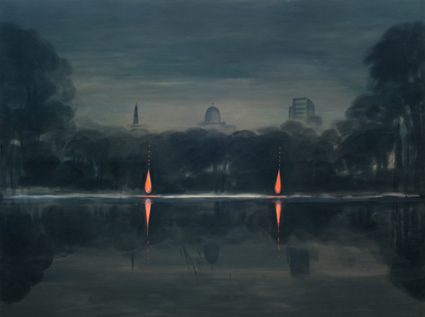 |
| Native Fires, 1996 |
Wanda Koop, a daughter of Russian immigrants who moved to Winnipeg as a child, has been awarded the country’s highest civilian honour, the Order of Canada. Over thirty years, her paintings and environments have generated a particularly strong sense of the space of the prairies, often combined with geometric intrusions suggesting the iimpact of modernity. I remembered her haunting landscape ‘Native Fires’ from the Parisian instantiation of ‘Winnipeg Now’, but it’s a richer painting given local context: the leading church, state and business buildings in Winnipeg loom out of the darkness beyond the Red River, beside which the flames lit by aboriginal peoples take on a tearful appearance suggesting that they’ve been curtailed, if not yet fully doused, by what lies behind them. ‘First Nations are still making fires along the river bank’, Koop has said, but ‘as the city encroaches and the river walkways are being expanded, and for as long as I can remember the police would come along and tell them to put their fires out’.
Michael Dudeck
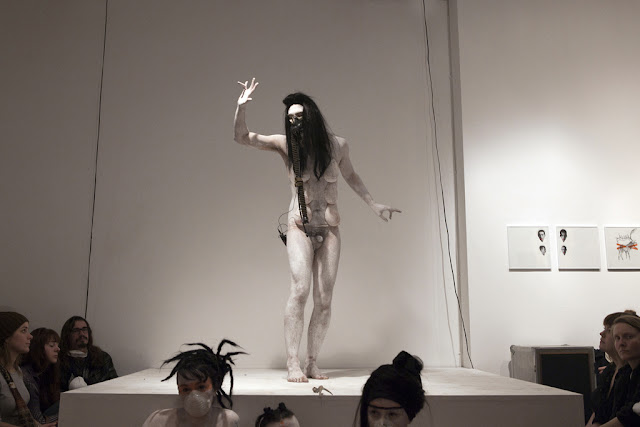 | ||
| Amygdala(Performance) |
At just 28, Michael Dudeck is one to watch: he’s four years into the project ‘Religion’: the multi-part creation of an alternative arctic world complete with its own language, fauna, religion and ceremonies. British readers might think of Charles Avery or Nathaniel Mellors for a flavour of the wild ambition, though Joseph Beuys must be a more relevant forerunner. Dudeck’s own performative role is as a queer Jewish witchdoctor, a part which, he happily agreed, he also enacts in his flamboyant ‘real life’ mode. As such, he’s part of the refreshingly mainstream gay identity of several Winnipeg artists: among his forerunners are Kent Monkman, Noam Gronick and Shawna Dempsey & Lori Millan – the latter pair were the Lesbian National Park Rangers who kept me under control during the long ‘Nuit Blanche’ of 29 September, when Winnipeg’s main galleries were open through to 5 a.m.
 |
| Esed (detail) |
From Dudeck’s perspective, ‘existing myths of origin didn’t cut it’, so his aim as a shaman in contemporary culture is to invent a queer religion and pre-history which restyles his own experiences. That intersects with the role of gender hybrids in many aboriginal myths, including those of Canada’s northern provinces: Dudeck talks of how ‘the hardships implicit in being blessed and burdened with a more complex framework’ were once recognised as holy.
.
‘Winnipeg Now’ included ghost-white sculptures of such Hyperborean creatures as excessively-antlered deer ‘doomed to wander in isolation for a thousand years across the haunting Age of Nothingness’; and a hermaphrodite baboon characterised by two ‘extensive serpentine phalli which are said to contain a second brain at their tips’. Dudeck also performed ‘Exegesis’, a 40 minute service of sacred texts chanted hypnotically to simple Moog backings. The hymns tell of prophecy, ritual death and spiritual hibernation, yet still manage to steal from pop songs.
Descriptions probably run the risk of making ‘Religion’ sound a little ludicrous, and Dudeck does play with that – but in practice his vision coheres into a compelling demonstration of the power of interpretative frameworks.
Sarah Anne Johnson
 |
| Party Boat |
Sarah Anne Johnson brings an unnerving single-mindedness to how she seeks to understand her own most formative experiences through art. That takes her well beyond her origins as a photographer – one who left Winnipeg temporarily to train at Yale under such as Crewdson, Simmons and diCorcia.
 |
| Bubble |
In a working method which puts me in mind of serial monogamy, Johnson has immersed herself in a student holiday job planting trees in deforested parts of Manitoba; eco-volunteering in the Galapagos; the life story of her grandmother, who was mistreated and made the subject of CIA mind control experiments when mentally ill; and the experience of the far north, joining a scientific expedition to sail through the arctic pack ice. Next up she’s planning to explore how she herself deals with intimacy, by using other couples making love as her surrogates.
| Sarah Anne Johnson in her studio with dog Kitty |
One unifying approach across these projects has been an urge to expand the photographic record by inhabiting the experience afresh, whether by modelling the site where things happened; using figurines to depict scenes not photographed, and photographing them as substitutes (which Johnson finds can have more emotional reality then ‘the real’ would have had); or by intensifying or repurposing photographs’ effects by chemical or painted interventions.
 |
| Untitled, Fireworks and schooner |
Not only did Johnson paint onto her ‘Arctic Wonderland’ photographs, magicking up the spirit of being there in a way which yet another photographic snowscape would struggle to do, she went on (for ‘Winnipeg Now’) to make a sculptural installation derived from one of those altered images. That’s a sort of re-inhabitation squared, and a 3D to 2D to 3D process which arrives at a new way of unifying photography, painting and sculpture. The environmental paradox whereby she was visiting the arctic in order to set up a critique of human activity there is at the heart of ‘Untitled, Fireworks and schooner’. Assorted plastic refuse makes up a firework-come-rainbow effect which hovers over a wooden boat inside which we can see the crew feeding the engine with wood. In the context of Johnson’s overall practice, it’s a psychologically charged scene which struck me as some kind of adult equivalent of Lacan’s mirror phase, whereby a child identifies with an external image as a means of separating out her own place in the world.
Simon Hughes
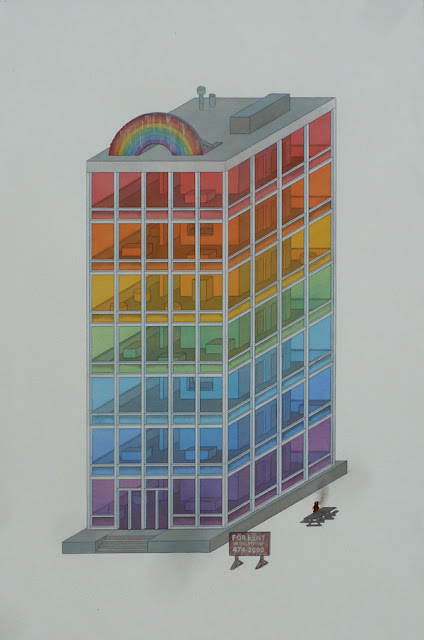 |
| Happy Place |
Winnipeg itself has a limited commercial art infrastructure – almost all of the work made in the city is sold elsewhere – but the biggest such space, Mayberry Fine Art, was showing Simon Hughes when I visited. He attended some classes alongside Royal Art Lodge members, but never quite joined the group (which he likened, convincingly, to a rock band).
| Simon Hughes in his studio overlooking the Red River |
Hughes has a wide range, including video, various styles of painting and collage, and the investigation of his children’s drawings. He tends to pursue particular strands within that mix across several years. Thus, he’s just coming to the end of a ten year cycle of precision-drawn watercolours of imagined buildings. They combine modernist architecture with the vernacular of log cabins, pushing the latter to implausible extreme, and are populated by stuck-on people representative of Canada’s history, including recurring participants from a set of stickers sold with the national flag. Hughes sees the buildings as representing the conflicted mental states which the occupants may be enacting.
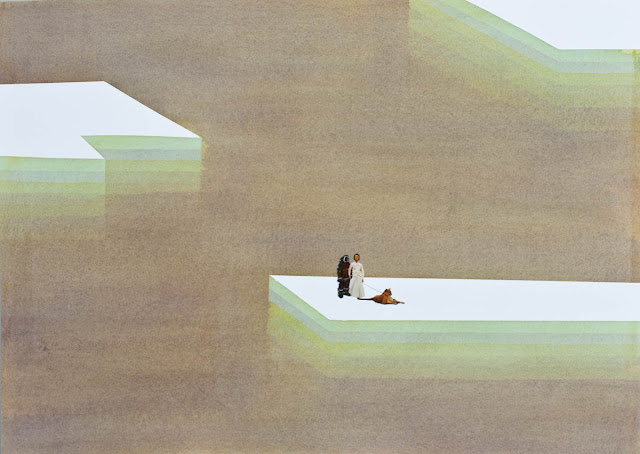 |
| Newlyweds |
Hughes’ strands do intersect, and ‘Newlyweds’ features the supposed unions both of his stock characters and also of an iceberg which has taken on the geometric angularity of a building. Again, metaphorical readings are available out of the contrasts of natural / traditional versus artificial / modern, which would suggest environmental or social critique, but Hughes’ world feels essentially optimistic: there’s an undercurrent of humour, the ice is attractively patterned, and the characters maintain their standard cheeriness whatever might be going on… though that, of course, is to stay on the surface.
Neil Farber & Michael Dumontier
| Library (detail) |
Michael Dumontier and Neil Farber didn’t stop collaborating when Winnipeg’s famous Royal Art Lodge collective ended in 2008: they carried on working together at least every Wednesday, but as a new duo rather than a continuation of the group. Dumontier’s solo work brings a minimalist simplicity to the conceptual slapstick which was typical of the Lodge. Farber on his own is a restless and hyper-productive experimenter from a base of spontaneous drawing, using, abusing and combining a dizzying range of paints, inks and collage elements in the service of the next wittily mordant apercu.
 |
| From ‘Animals with Sharpies’ |
The first part of ‘My Winnipeg’, at Plug In, features a project which brings those approaches together. The 15 foot wide ‘Library’ (2008-12) is made up of hundreds of matt-on-wood paintings, varying in size, but each depicting one book, and translating the literary into a multicoloured homage to geometric abstraction. Zooming in, one sees that Dumontier’s tomes teem with Farberesque titles: ‘Abandon Your Inner Tube’, ‘Speaking and Kissing in Tongues’, My First Wedding’ and ‘Zinky’ caught my eye, along with ‘We Sold Our Son to a Witch and Our Daughter to a Hypnotist’.
Will the freshness run out? It seems unlikely: Farber is confident, after 16 years of collaboration, that each new idea he and Dumontier have will continue to branch into several further possibilities…
Karel Funk
 |
| Untitled #53, 2012 |
Karel (say ‘Carl’) Funk’s name has East European origins, but he was born in Winnipeg in 1971. His work is the epitome of intense application to a narrow range of focus: for fifteen years he has painted nothing but heads, often turned away or hidden by clothing which Funk provides. Nor has his basic technique changed: Funk himself takes multiple photographs of the subject, shot in the studio downstairs from his living space; 3 or 4 of that then form the starting point for the most basic of underdrawings on an MDF board, followed by hundreds of semi-translucent layers of acrylic. That fills out the image in a level of investigative detail which persuades equally from close to or far from the canvas. Funk works on one painting at a time, as a systematic full-time job, and finishes five in a good year.
| Karel Funk in his basement-come-studio |
Yet when he talks you through his development, it seems both more grounded in necessity and more engaged with change than you might expect.
 |
| Untitled #39, 2008 |
The strength of Funk’s originating idea is clear. He echoes the techniques of renaissance portraiture and catches its associated spiritual intensity, but avoids any direct engagement between subject and viewer – hence eyes are closed if seen at all, and hence his decision for some years not to depict women, which could have opened up issues around the male gaze (see eg John Currin). That switches our attention to the abstract qualities of the painting, and to the implications of an unknowable inner life. It’s a solipsistic vision which Funk has compared with the isolating yet intimate effect of being crushed up behind someone on a subway. Meantime, he dedicates himself to exacting description of ‘modern drapery’ – typically windbreaker jackets or hoodies, complete with seams which act like Newman’s ‘zips’.
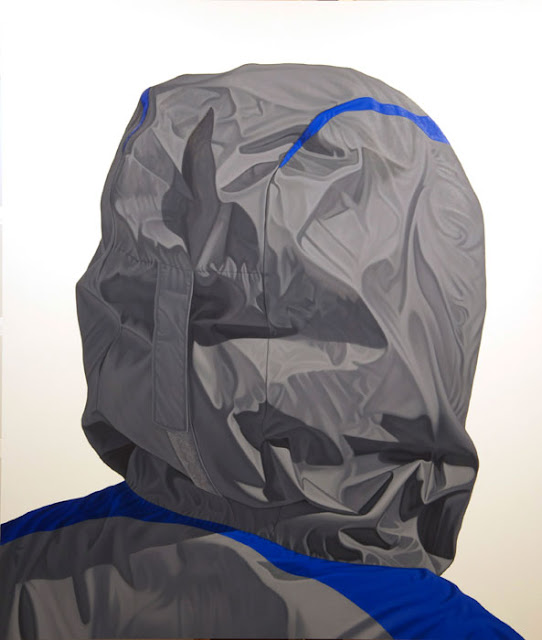 |
| Untitled #52, 20122 |
What may seem small changes to this formula are big issues for Funk, not least because if an experiment fails that’s three months of work with nothing to show for it. Over the years, though, his scale has slowly increased to approaching double life size; more visible flesh has been allowed; backpacks have just been added to the repertoire and figures who are definitely women introduced. It’s not exactly ‘rip it up and start again’, but perhaps that reflects the persistence needed to achieve change in an isolated community defined by its frequent need to wear coats…
Images courtesy of the relevant artists + Winnipeg Art Gallery (Koop, Johnson sculpture), Galen Johnson (Maddin), Stephen Bulger Gallery (Johnson), Leif Norman /Pari Nadimi Gallery (Dudeck), 303 Gallery (Funk)
Main Photo: Marcel Dzama: still from Death Disco Dance





